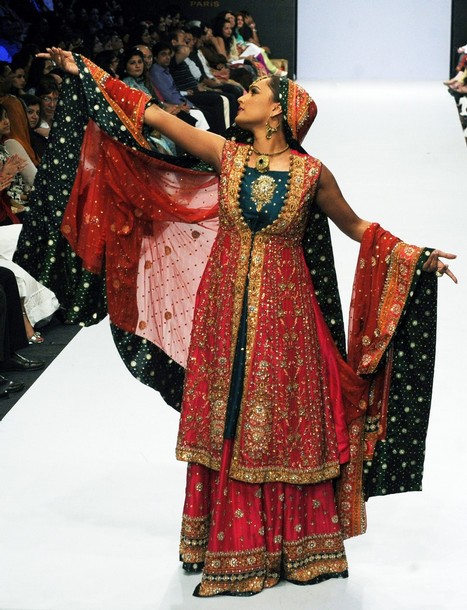Bridal Dress Biography
source(google.com.pk)
Pakistan is a Muslim state where marriages are a religious duty and people prepare for marriages with extra and great efforts. Marriage is the very especial occasion of ones life, Pakistani brides prepares their all marriage items, accessories, dresses, shoes with extra effort and the element of uniqueness is the main and important part of Pakistani bridal dress.Main Functions of Wedding
Although are bridal dresses are made with especial efforts and are unique but there four main and important days and for these days four especial and unique bridal dresses are made. First day is mayun, for the day of mayun Pakistani bridal dress is of yellow color. The second day that is called as mehendi is also of great importance and for mehendi day green or yellow dress is made. Third day is called as Wedding or shadi day when the according the Islamic agreement i.e Nikah bride leaves her family and home forever and migrate to her husband's house, for wedding day mostly red or maroon colored dress are made and these dresses are called as Sharara or gharara. Shara ana gharara are also made for the fourth and final day of marriage that is called Valima day.
Bridal Dress
Bridal dresses can be made in different colors. Embroidered lehangas are also inn in wedding trends from many past years. Mostly the embroidery is done with moti, sitara, dabka, kundan and other embroidery styles.
The bride-cup was the bowl or loving-cup in which the bridegroom pledged the bride, and she him. The custom of breaking this wine-cup, after the bridal couple had drained its contents, is common to both the Greek Christians and members of the Jewish faith. It is thrown against a wall or trodden under foot. The phrase "bride-cup" was also sometimes used of the bowl of spiced wine prepared at night for the bridal couple. Bride-favours, anciently called bride-lace, were at first pieces of gold, silk or other lace, used to bind up the sprigs of rosemary formerly worn at weddings. These took later the form of bunches of ribbons, which were at last metamorphosed into rosettes.
The bride-wain, the wagon in which the bride was driven to her new home, gave its name to the weddings of any poor deserving couple, who drove a "wain" round the village, collecting small sums of money or articles of furniture towards their housekeeping. These were called bidding-weddings, or bid-ales, which were in the nature of "benefit" feasts. So general is still the custom of "bidding-weddings" in Wales, that printers usually keep the form of invitation in type. Sometimes as many as six hundred couples will walk in the bridal procession.
The bride's wreath is a Christian substitute for the gilt coronet all Jewish brides wore. The crowning of the bride is still observed by the Russians, and the Calvinists of Holland and Switzerland. The wearing of orange blossoms is said to have started with the Saracens, who regarded them as emblems of fecundity. It was introduced into Europe by the Crusaders. The bride's veil is the modern form of the flammeum or large yellow veil that completely enveloped the Greek and Roman brides during the ceremony. Such a covering is still in use among the Jews and the Persians
Bridal Dress
Bridal Dress

Bridal Dress

Bridal Dress

Bridal Dress

Bridal Dress

Bridal Dress

Bridal Dress

Bridal Dress

Bridal Dress


No comments:
Post a Comment